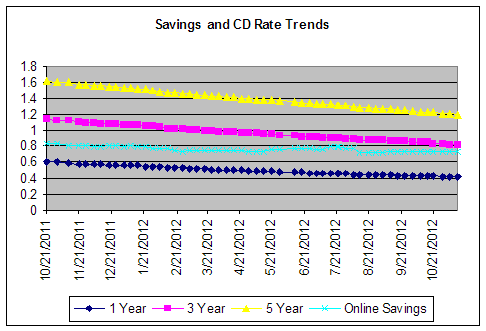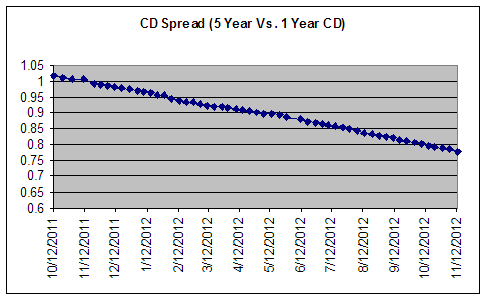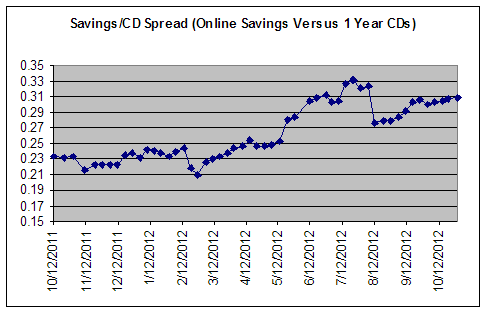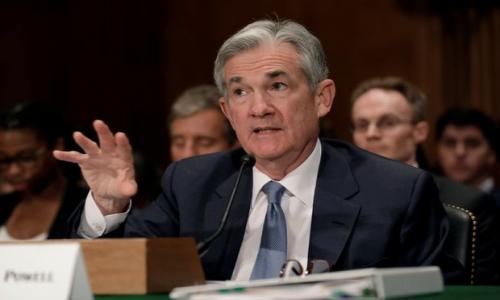Savings and CD rate averages continued to decline last week, with the one year CD average falling from .419% to .418% APY. Five year average CDs fared even worse falling from 1.204% APY to 1.196% APY. Online savings rates from the banks offering the top 30 nationally available rates remained steady at .732% APY for the seventh week in a row.

Election Impact on Savers
With the election over we can now look towards the fiscal cliff as the next big event that may impact the fortune of savers. Here are a couple of scenarios and some thoughts on how each one might impact savers.
- We go over the cliff. Taxes will rise across-the-board, including on income from savings and CDs. As a result, the already meagre gains from money in the bank will become even smaller. As the economy slows from tax increases and spending cuts, the government will keep interest rates pegged at record low rates for an even longer period of time.
- The cliff is averted via a temporary detour. Congress and the President decide that in this lame-duck period (for Congress) to bypass the fiscal cliff and put in a temporary respite from tax increases and budget cuts. This will maintain the status quo. Rates will remain low for an extended period of time (perhaps through 2016) on deposit accounts but no significant new taxes will be taken out of income.
- A grand bargain is struck to avert the cliff. A grand bargain is potentially the best outcome for savers, depeneding on the contours of the deal. A compromise would show that the government can still function and boost confidence in the economy. Most of the compromises being discussed now would not increase income taxes on the vast majority of savers. So, increased confidence and little to no tax increase may result in higher rates in the medium term as the economy continues to grow and recover from the financial crisis of 2008.
Savings Options
Should a saver open a savings account or a CD? A shorter-term CD or a longer one? The chart below shows the comparison between the yield of a 5-year CD and a 1-year CD. Notice that this difference has shrunk considerably over the past year as the yield on 5-year CDs has dropped by more than the yield on a 12-month CD. This drop continued last week.

Not much has changed with the various product spreads. While the spread started the year at 1% or 100 basis points, it is now .778%. As a comparison, in 2008, this spread stood at .43% while in 2010 it went as high as 1.56%. So right now, it's somewhere in the middle. Why does this matter? Because back in 2010 banks were paying a saver a lot more to invest in a 5 year CD versus a 1 year. Today, banks are giving about half the premium they did a few years ago to lock up your money for 5 years. In 2012, I advised savers to consider investing in 5-year CDs because of this premium: the economy looked stuck for quite some time, and inflation did not appear to be a problem. Now, with the premium down, and the economy growing (albeit not that fast) it's a bit of a harder case to make. If the government takes the economy over the fiscal cliff, then it makes sense to put money in longer-term CDs as the potential for another recession becomes much higher. If a compromise can be reached, I'd invest in shorter-term CDs. Consumers might want to consider laddering their CD portfolio in this rate environment.
What about the comparison between savings and CDs?

This spread has actually been growing. Online savings rates have, for the most part, maintained their rates while CD rates continue to fall. For short term savings, it appears to make more sense to park money in an online savings account versus a CD. Online savings accounts have remained very stable over the past year.
Interest Rates
My rate prognosis depends on what happens with the fiscal cliff. The most likely scenario is that a temporary fix is put in place that averts a jump in taxes and cuts due to sequestration. Based on that, I believe that:
Rates will continue to drift lower for the next 12 months. After that, it's hard to tell. I suspect that rates may go up before 2015.
For now though, savers can make the best of a tough situation by getting the very best rates on their money. Remember, even in today's environment, there is competition for your cash.
I hope this is helpful. If it is, let me know and I'll keep writing. Drop me a note or post a comment below.
Have a nice week. Until next week...













Add your Comment
use your Google account
or use your BestCashCow account